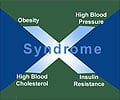The International Diabetes Federation (IDF) has launched a new definition to identify children and adolescents at increased risk of developing type 2 diabetes and cardiovascular disease in later life. The definition is published in The Lancet(1) today.
The metabolic syndrome is a cluster of the most dangerous risk factors for type 2 diabetes and cardiovascular disease. Its early identification is very important to facilitate preventive action. This first simple, unified definition from IDF for children and adolescents is consistent with that available for adults(2)."Diabetes and cardiovascular disease cause death and serious disability," said Professor Paul Zimmet, Chair of the IDF Task Force on Epidemiology and Prevention and co-author of the definition. "Almost 4 million deaths every year are a consequence of diabetes-related causes. And with diabetes set to reach 380 million people within a generation, the death toll can only rise.(3) This is the first generation where children may die before their parents." Intrauterine events for the unborn child and factors during early development years predispose a child to disorders such as obesity, prediabetes, and metabolic syndrome. At the same time, urbanization, unhealthy diet and sedentary lifestyle are increasing the risks for the coming generations.
The new definition is simple and easy to apply in clinical practice.
Waist measurement is the main component. Percentiles, rather than absolute values of waist circumference have been used to compensate for variation in child development and ethnic origin.
The definition is divided according to age-groups: age 6 to 10; 10 to 16; and 16 or older. IDF suggests that the metabolic syndrome should not be diagnosed in children younger than 10, but that a strong message for weight reduction should be delivered for those with abdominal obesity.
For children age 10 or older, metabolic syndrome can be diagnosed with abdominal obesity (using waist circumference percentiles) and the presence of two or more other clinical features (elevated triglycerides, low HDL-cholesterol, high blood pressure, increased plasma glucose). Although some of these as well as body size and proportions change with age and development, in the absence of contemporary definitive data, the criteria adhere to the absolute values in IDF's adult definition. The exception is that one (rather than a sex-specific) cut-off is used for HDL. For children older than 16, the IDF adult criteria can be used.
Advertisement
The International Diabetes Federation (IDF) is the global advocate for almost 250 million people with diabetes worldwide. It represents 200 diabetes associations in more than 150 countries. Its mission is to promote diabetes care, prevention and a cure worldwide. IDF is a non-governmental organization in official relations with the World Health Organization.
Advertisement
SRM/M







